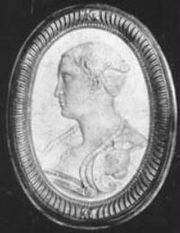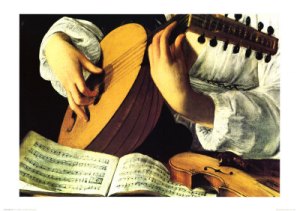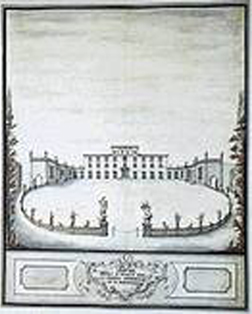Francesca Caccini at the Medici Court
Suzanne Cusick has graciously provided the following essay on Francesca Caccini and La Liberazione di Ruggiero. The essay is an adaptation of remarks made on February 3, 2006 at Smith College on the occasion of a performance of La Liberazione directed by Drew Minter. The essay benefits from Professor Cusick’s lifelong research into this remarkable woman and much of the material became part of her extraordinary monograph published earlier this summer: Francesca Caccini at the Medici Court: Music and the Circulation of Power (2009, University of Chicago Press. ISBN 0-226-13212-9).

Francesca Caccini
Francesca Caccini was born in mid-September 1587, the first-born child of two singers then on salary to produce chamber and theatre music for the Medici court–Lucia Gagnolandi, and Giulio Caccini (who was himself the second son of an ambitious wood dealer from Pisa). By 1587 Giulio was already one of the best-known singers and singing teachers of his generation, and the one professional singer known to have regularly participated in the conversations at courtier Giovanni de’Bardi’s Fiesole villa (known as La Camerata) that are supposed to have led to the two most stunning musical innovations of the 17th-century–the invention of a new kind of solo song, and the closely-related invention of new ways of setting plays to music that led directly to the emergence of opera as a genre.
At 13 Francesca sang in the first more-or-less publicly performed opera, L’Euridice, joining her sister Settimia, her step-mother Margerita, and various other pupils of her father to sing the female and the choral parts of the show that had been assigned to Giulio’s composition. At 17, she so impressed the King of France, Henri IV, with the literary sensitivity of her singing in French that the King asked to have her as a musical servant to his household. In the winter before she turned 20 she composed her first theatrical work for the Medici court–a kind of mock sword fight preceded by musico-dramatic dialogue called a barriera. The show’s success seems to have led directly to her hiring by the Medici court as a musica (an all-round musical servant) two months after her 20th birthday; in keeping with local custom, she was married to another musical servant the same week she appeared on the court’s payroll (although, contrary to the prevailing custom, her dowry was paid by her father, not by the court).
According to a biographical sketch penned between 1627 and 1630 by a man who had then known her as a court colleague for 15 years, Cristoforo Bronzini, the adult Francesca was an industrious, talkative woman who compensated by talent, charm, cheerfulness and gracious manners for the fact that, in his words, “she had not been well endowed by nature”. Francesca had been alone among her father Giulio’s 10 children in receiving something close to a humanist education. This “girl of the sharpest intelligence”, as Bronzini called her, was taught Latin, some Greek, rhetoric, grammar, and languages well enough that she was remembered for writing, as a 12-year-old, a commentary on books 3 and 4 of the Aeneid, and for her adult ability to improvise songs to poetry in Latin, Italian, French, Spanish, German, and several Italian dialects. Constantly eager to learn new things, Francesca seems to have been especially interested in mathematics–arithmetic, geometry and astrology–in the occult sciences, and in philosophy, which, Bronzini says, “she would have studied further had she been able, like Astenia and some others, to wear boy’s clothing to attend the public schools”. Her musical studies, he tells us, were at first a minor part of her education, pursued as a pastime, and “to please her father”.
By the time she impressed the King of France, she was known as much for her skills on the harp, harpsichord, lute, theorbo and guitar as for her singing, and she was said to be able to play any stringed instrument well. Sometime before she was 20, Tuscan Granduchess Christine de Lorraine noticed her talent, and arranged for her to study counterpoint, to marry a handsome, impoverished, respectable tenor on the court’s staff, Giovanni Battista Signorini, and to be hired as a musician of the Granducal court.
In the 20 years that followed, Francesca Caccini performed regularly for the private pleasure of the Medici family–that is, for two Grand Dukes, and for their wives, children, cousins, nephews, nieces, and guests. Annually, during the last three days of Holy Week, Florentine melophiles could be sure of hearing her publicly, when she participated in the poly-choral performances of “the Offices”, singing from the balcony, and behind the grate where the ruling family themselves sat–as if her voice, mixing with those of her own family and pupils, sang in the place of the rulers’. Witnesses to her performances reported that:
“…whenever it suited her, this same woman …could by her singing and playing kindle astonishment and boldness in the breasts of her listeners, so that they would agree to any undertaking, no matter how burdensome…with the soft sound of her playing and the sweetness of her song she invited every breast (even if opposed to chaste intentions) to pure self-containment and integrity…as matched her own…”
In addition, Francesca composed hundreds of songs and duets in the new style her father claimed to have invented, all but 36 of them lost; she taught the daughters of Medici servants or of Florentine professionals who aspired to musical positions at court, paid for her work either by the court or by the girls’ parents, and she taught music to the Medici children, to the daughters of their favorite government ministers, and perhaps to the daughter of Galileo (in whose home conversazione she is known to have participated); and, often collaborating with colleagues Marco da Gagliano and Jacopo Peri, she composed some of the music for at least 17 court-based entertainments–balli, comedies for Carnival, mascherate, sacred operas–many of them shows authored by and little shows put on by and for the households of the two Medici Grand Duchesses (that is, their dame and donne, their children, and such professionals as were needed to serve as ‘ringers’ or onstage coaches–these last were usually Caccini herself, along with some of her artisan-class pupils).
The show that Magnificat will present October 16-18, La liberazione di Ruggiero, is the only one of these to survive nearly intact (excerpts from several others exist). When she got the gig to compose it (probably working from a barely-sketched libretto and scenic plan), Francesca was the highest paid musician at the Medici court, an intimate of the royal’s domestic spaces (though always a servant in their eyes), and a person whose special gifts to the court were her ability as a composer to make her patrons “laugh from the heart” and her ability, as both a singer and musician, “to make her listeners do whatever she wanted…”
By the time Caccini’s first husband died in late December 1626, she had borne him only one child, Margerita, born 14 years after her parents married. Left only with the property her own dowry had bought, the household goods her husband’s will specified had all been purchased with her salary, and a nice collection of jewels given to her by those who admired her performances, she arranged immediately to remarry.
Two weeks after her 40th birthday, she married a minor nobleman from Lucca, Tomaso Raffaelli, a man about whom others noted his intense melophilia, the richness of his instrument collection, and his Ganymede-like manner. When Raffaelli died three years later, Francesca had borne him a son. As Raffaelli’s widow and the guardian of his noble son, Francesca enjoyed the lifelong usufruct of his estate and something even more precious–a tenuous but plausible hold on the noble status for which her education but *not* her 20 years of hard work had prepared her. She returned to Florence in 1634, where she again served the Medici women (never singing again in public, but apparently making music and teaching the princesses in their convent home) until her daughter Margherita was settled in life–life as a virtuosa musician in a convent that adjoined the principal Medici palace–in 1640.
In May, 1641, Francesca left Medici service forever, and disappeared from the public record.





















 The connection between the nascent Italian theater of the 16th Century, commonly referred to as “commedia dell’ arte”, and the development of opera at the end of that century has been well established by musical scholars. Nino Pirrotta, in a memorable
The connection between the nascent Italian theater of the 16th Century, commonly referred to as “commedia dell’ arte”, and the development of opera at the end of that century has been well established by musical scholars. Nino Pirrotta, in a memorable  La liberazione di Ruggiero fits into the Tuscan court’s long-term pattern of representing powerful women. Its setting at Villa Imperiale, its nearly all-female cast, and its plot focus on the contest between two women over the sexual and political destiny of a young man all invited its first audience to imagine they were being given a glimpse of the gynecentric, feminizing world they feared. It invited them to confront and resolve their anxieties about local women’s sexual and political power in an entertaining way, by inviting them to suspend temporarily the boundary separating representation and reality, in the very space most associated with that power. It invited them, too, to a resolution in which they could imagine themselves liberated from effeminacy (or from unreasonable gynephobia) through the agency of an unnaturally powerful but benevolent female, the sorceress Melissa.
La liberazione di Ruggiero fits into the Tuscan court’s long-term pattern of representing powerful women. Its setting at Villa Imperiale, its nearly all-female cast, and its plot focus on the contest between two women over the sexual and political destiny of a young man all invited its first audience to imagine they were being given a glimpse of the gynecentric, feminizing world they feared. It invited them to confront and resolve their anxieties about local women’s sexual and political power in an entertaining way, by inviting them to suspend temporarily the boundary separating representation and reality, in the very space most associated with that power. It invited them, too, to a resolution in which they could imagine themselves liberated from effeminacy (or from unreasonable gynephobia) through the agency of an unnaturally powerful but benevolent female, the sorceress Melissa.









 Reba Wissner of Brandeis University has posted a thoughtful review of Suzanne Cusick’s recently published book,
Reba Wissner of Brandeis University has posted a thoughtful review of Suzanne Cusick’s recently published book,